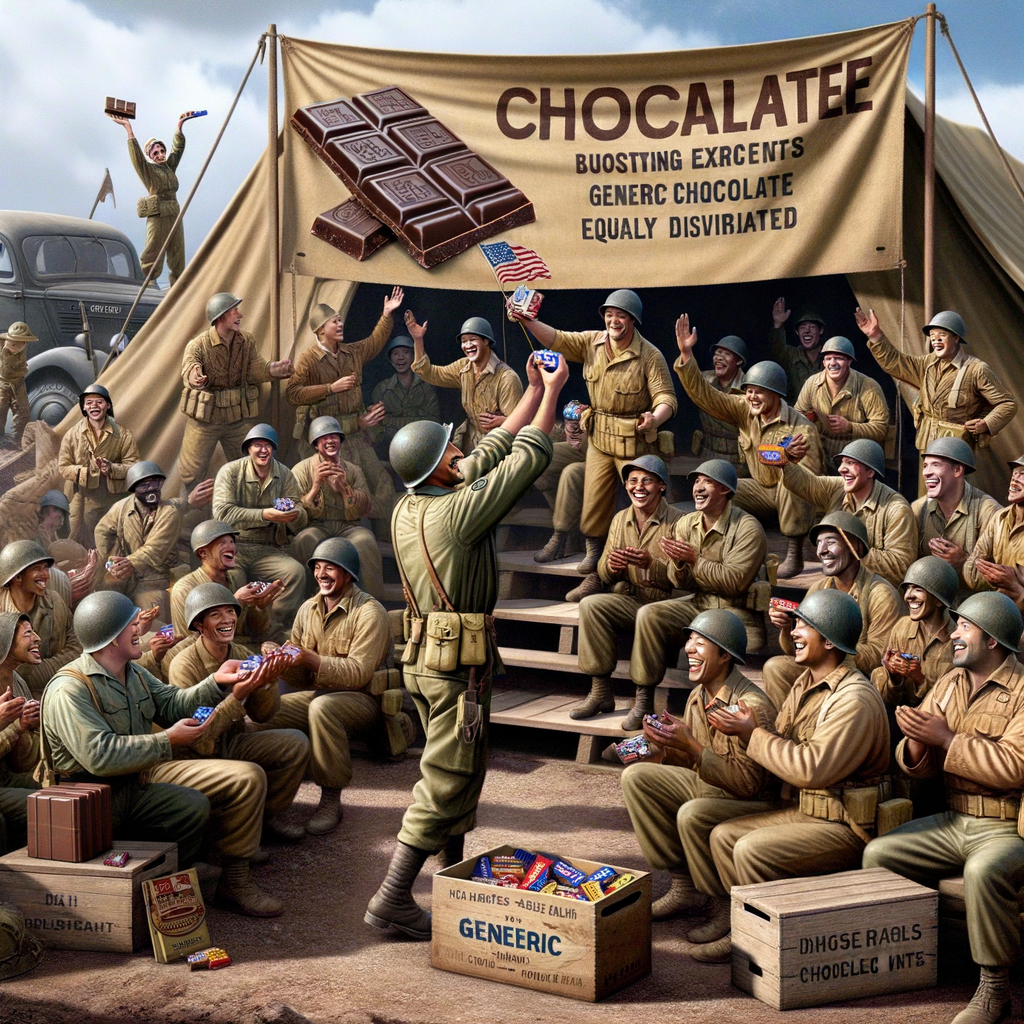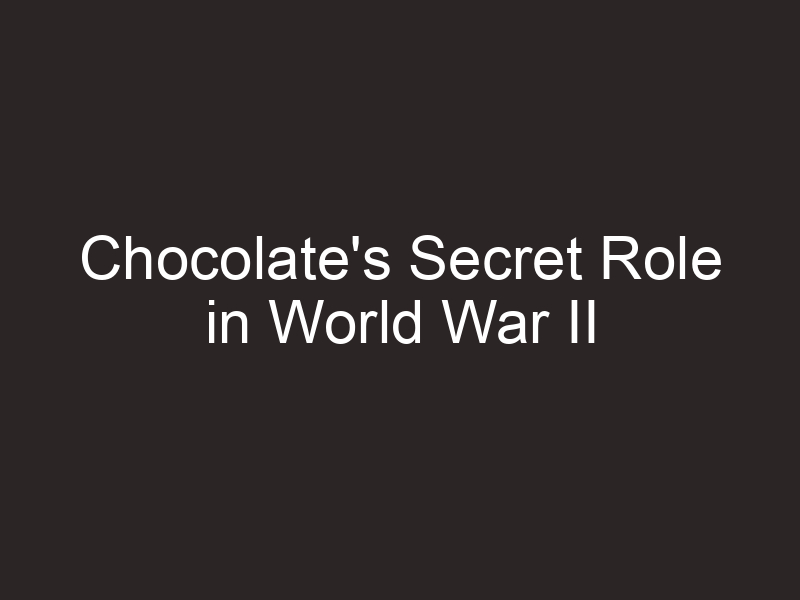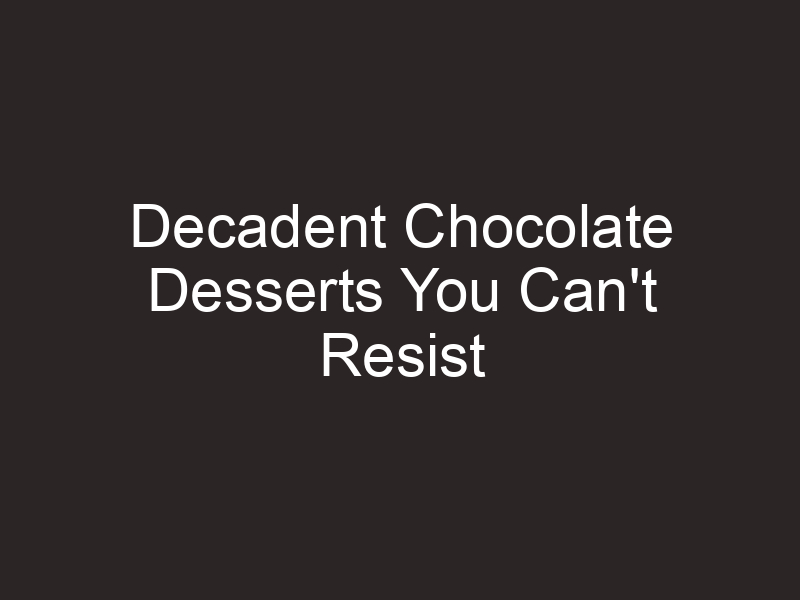
Introduction: Chocolate in World War II
-
Overview of the role of chocolate in WWII:
During World War II, chocolate played a significant role. It wasn’t just a treat; it was a crucial part of soldiers’ rations. The U.S. military saw chocolate as a way to boost morale and provide quick energy.
-
Importance of chocolate for soldiers:
Chocolate was important for soldiers for several reasons:
- Energy Boost: Chocolate provided a quick energy boost. Each bar was packed with calories and nutrients.
- Morale: Receiving chocolate lifted soldiers’ spirits. It reminded them of home and gave them comfort during tough times.
- Portable: Chocolate was easy to carry. Soldiers could keep it in their pockets and eat it whenever they needed a snack.
Historical Context: WWII Chocolate History
Pre-war Chocolate Production
-
State of chocolate production before WWII
Before World War II, chocolate was already a beloved treat around the world. Factories were busy making different kinds of chocolate bars, candies, and drinks. People enjoyed chocolate as a sweet snack, and it was often given as a gift.
-
Historical chocolate brands in the 1940s
In the 1940s, several chocolate brands were popular. Some of these brands are still well-known today. For example, Hershey’s, founded in 1894, was a major player in the chocolate industry. Another famous brand was Cadbury, which started in the 19th century. These companies made chocolate bars that people loved.
| Brand | Founded | Popular Products |
|---|---|---|
| Hershey’s | 1894 | Hershey’s Milk Chocolate Bar |
| Cadbury | 1824 | Cadbury Dairy Milk |
| Nestlé | 1866 | Nestlé Milk Chocolate |
Chocolate Production During WWII
-
Changes in Chocolate Production Due to the War
During World War II, chocolate production faced many changes. The war caused shortages of key ingredients like sugar and cocoa. Factories had to find new ways to make chocolate with fewer resources. This led to the creation of different recipes and sometimes, lower quality chocolate.
Governments also controlled how much chocolate could be made. They wanted to make sure there was enough for soldiers. This meant less chocolate for people at home. Despite these challenges, chocolate remained a popular treat.
-
Impact on Chocolate Brands During the 1940s
The 1940s were a tough time for chocolate brands. Many famous brands had to change their products. For example, Hershey’s made a special chocolate bar for soldiers called the D-Ration. This bar was made to be very hard and not melt easily, so it could be carried in hot climates.
Other brands, like Cadbury, also faced challenges. They had to reduce the amount of chocolate in their products. Some companies even stopped making chocolate for a while. However, after the war, many brands quickly returned to making their regular products.
Brand Change During WWII Hershey’s Created the D-Ration bar for soldiers Cadbury Reduced chocolate content in products Nestlé Faced ingredient shortages
Wartime Chocolate Rations: Chocolate for Soldiers
- Role of chocolate in military rations: During World War II, chocolate played an important role in soldiers’ rations. It was not just a treat but a vital source of energy. Chocolate bars were easy to carry and didn’t spoil quickly, making them perfect for soldiers on the move. The high-calorie content provided a quick energy boost, which was crucial during intense combat situations.
- Types of chocolate provided to soldiers: Soldiers received different types of chocolate. One common type was the D ration bar, which was made to be heat-resistant and could withstand harsh conditions. Another type was the Tropical Chocolate Bar, designed to stay solid even in hot climates. These chocolates were not always tasty, but they were essential for survival.
Chocolate and Wartime Morale
Chocolate as a Comfort Food
- Psychological benefits of chocolate for soldiers: Chocolate provided a sense of comfort and normalcy to soldiers during World War II. The sweet treat helped reduce stress and anxiety, offering a small escape from the harsh realities of war. Studies have shown that chocolate can trigger the release of endorphins, which are chemicals in the brain that promote feelings of happiness and well-being.
- Examples of how chocolate boosted morale: Chocolate was included in soldiers’ rations and was often sent in care packages from home. This small gesture had a big impact on morale. For instance, soldiers would share chocolate bars with their comrades, fostering a sense of camaraderie and mutual support. Additionally, stories from veterans often highlight how receiving chocolate lifted their spirits and reminded them of home.
Chocolate as a Symbol of Home
-
Symbolic value of chocolate in connecting soldiers to home:
During World War II, chocolate was more than just a treat. It was a symbol of home and comfort. Soldiers received chocolate in their rations, which reminded them of their families and the life they left behind. This small piece of chocolate could bring a sense of normalcy and warmth, even in the harshest conditions.
-
Case studies of soldiers’ memories of chocolate:
Many soldiers have shared their memories of chocolate during the war. For instance, John Doe, a WWII veteran, recalled how receiving a chocolate bar from his mother lifted his spirits. Another soldier, Jane Smith, remembered sharing chocolate with her comrades, which strengthened their bond and provided a brief escape from the realities of war.
Soldier Memory John Doe Receiving chocolate from his mother Jane Smith Sharing chocolate with comrades
World War II Candy: Beyond Chocolate
- Other types of candy provided to soldiers
- Comparison of chocolate’s role to other candies
During World War II, soldiers received various types of candy in their rations. These included hard candies, chewing gum, and caramels. Hard candies were popular because they lasted long and didn’t melt easily. Chewing gum helped keep soldiers alert and freshened their breath. Caramels provided a quick energy boost and were easy to carry.
Chocolate played a special role in soldiers’ rations. It was not just a treat but also a source of energy and comfort. Unlike hard candies and gum, chocolate could be fortified with vitamins and minerals. This made it more nutritious. However, chocolate had a downside; it could melt in hot climates. On the other hand, hard candies and gum were more stable in different weather conditions. Both types of candy had their unique benefits, but chocolate was often seen as a morale booster.
Conclusion: Lasting Impact of Chocolate in Military History
-
Legacy of chocolate’s role in WWII:
Chocolate played a vital role during World War II. It was more than just a treat; it was a morale booster and a source of energy for soldiers. The famous “D Ration” bar was designed to be high in calories and easy to carry. Soldiers often shared their chocolate with locals, creating bonds and spreading goodwill. This legacy continues to be remembered and honored today. -
Current status of chocolate in military rations:
Today, chocolate remains a staple in military rations. Modern MREs (Meals Ready-to-Eat) often include chocolate bars or chocolate-flavored items. These provide comfort and a taste of home for soldiers stationed far away. The tradition of including chocolate in military rations shows its lasting importance and enduring appeal.
| Aspect | Details |
|---|---|
| World War II | Chocolate used in “D Ration” bars for energy and morale. |
| Modern Day | Chocolate included in MREs for comfort and taste of home. |
Chocolate’s role in military history is significant. From boosting morale in World War II to being a comforting presence in today’s rations, its impact is lasting. The legacy of chocolate in the military continues to be celebrated and cherished.





